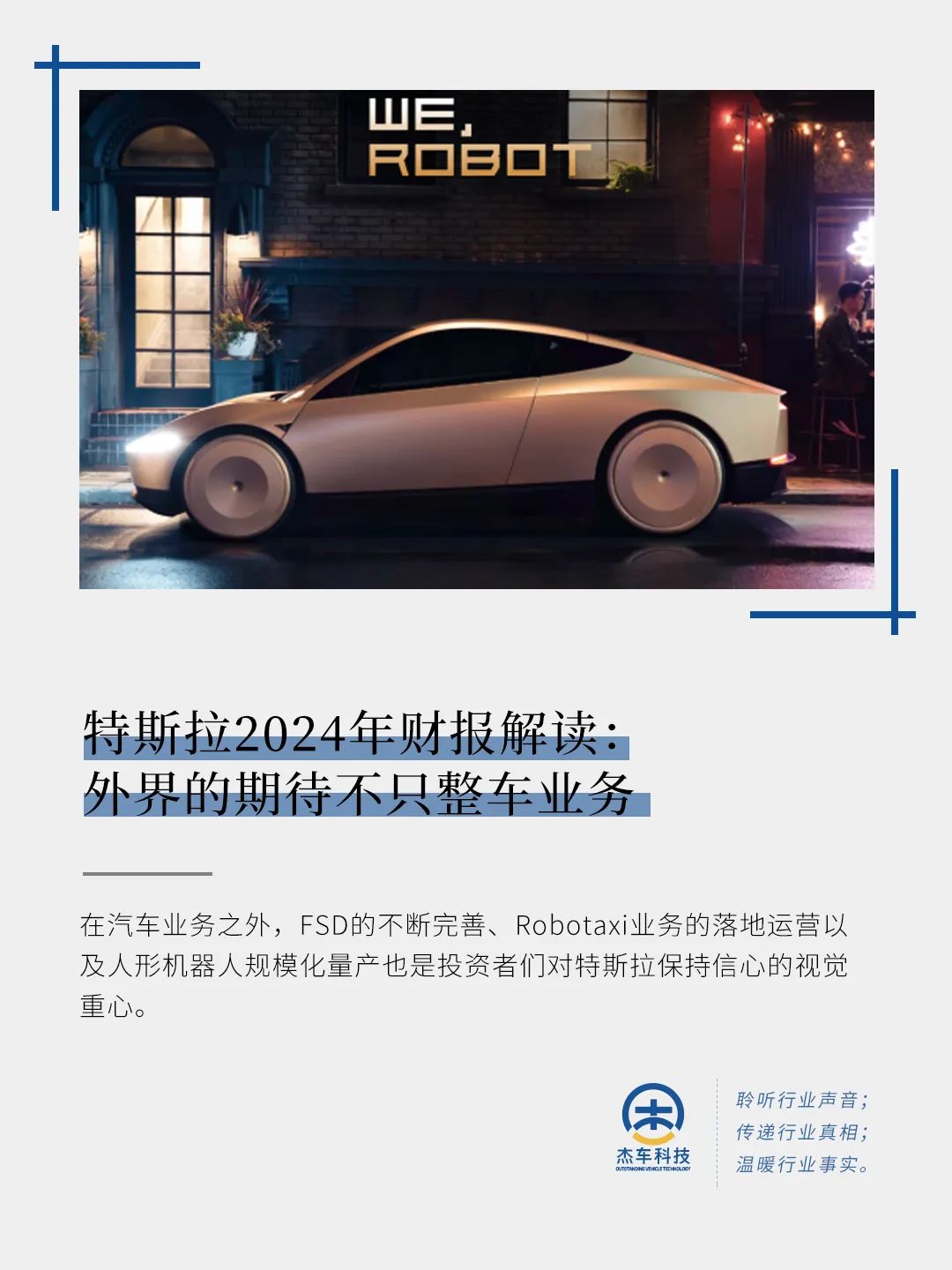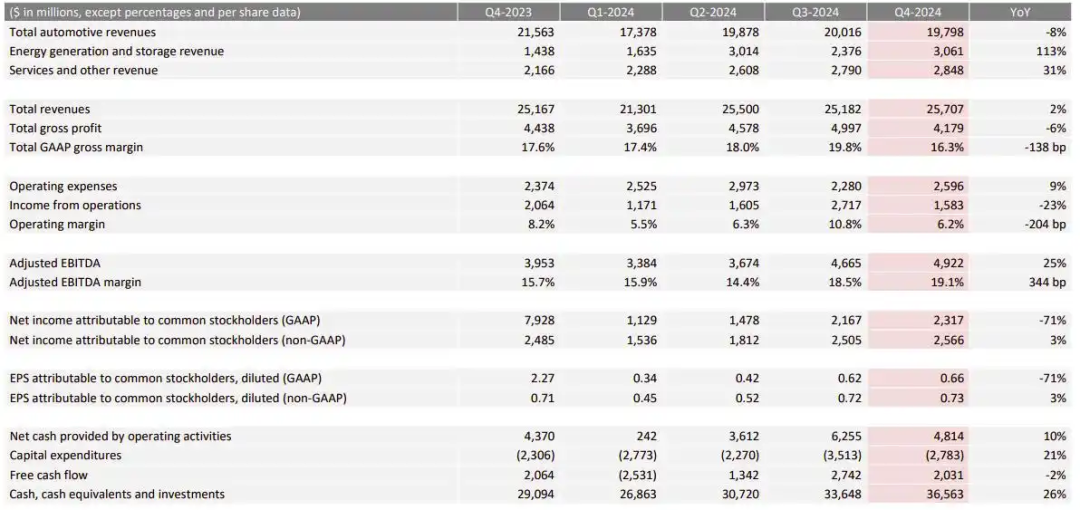Tesla's 2024 Financial Report Analysis: Beyond the Vehicle Business
![]() 02/19 2025
02/19 2025
![]() 508
508

By Chen Buqi
Produced by Jieche Technology
In the global new energy market, Tesla stands as a clear leader, with its market influence undeniable. However, the recently released 2024 financial report revealed a noticeable trend of sluggish growth.

On January 30, Tesla announced its full-year 2024 financial results. The report indicated revenue of $97.7 billion, a marginal 0.9% increase year-on-year, while net profit stood at $7.15 billion, a significant 52.2% decrease.
The fourth quarter saw even starker conditions. Tesla's key financial metrics fell short of market projections, with net profit plummeting year-on-year. Revenue amounted to $25.71 billion, missing market expectations of $27.15 billion, and up slightly from $25.167 billion in the same period last year. Net profit stood at $2.317 billion, a sharp 71% decline from the $7.928 billion recorded in Q4 2023, largely due to a one-time non-cash tax benefit of $5.9 billion in the previous year.
Specifically, Tesla manufactured approximately 459,000 new vehicles in Q4 2024, a 7% decrease year-on-year, while deliveries totaled around 496,000, a 2% increase. For the full year 2024, Tesla produced approximately 1.773 million electric vehicles globally, down 4% year-on-year, and delivered approximately 1.789 million, a 1% decrease, undershooting expectations.
As Tesla's current revenue mainstay, the automotive business generated total income of $77.1 billion in 2024, a 6% year-on-year decrease, primarily explaining the financial report's underperformance.

In contrast to other automakers' vigorous model updates and iterations, Tesla focused its 2024 efforts on advancing autonomous driving and Robotaxi, displaying a relatively lax approach to its automotive business. Since the refreshed Model 3's launch on September 1, 2023, Tesla made no model changes or upgrades throughout 2024.
In the SUV-dominated Chinese mainland market, the Model 3, positioned as a mid-size sedan, naturally lacks a competitive edge. Coupled with controversial design choices like steering wheel shifting and button turn signals, Model 3 sales remained lukewarm, prompting Tesla to introduce a five-year interest-free policy in July 2024 to boost sales. Despite this, Xiaomi's SU7 outsold the Model 3 by nearly 5,000 units in December 2024.
As the sales leader, the Model Y, despite benefiting from the new energy vehicle and SUV market boom, faces fierce competition from other manufacturers. "Surrounding Guangmingding, we must bring out all our strength." On October 13, 2024, Shao Mingfeng, general manager of sales at Lantu, stated at the Lantu Zhiyin launch event. Thus, with the launch of Lantu Zhiyin, along with Avita 07, IM Motors LS6, ZEEKR 7X, Letao L60, and IM Motors R7, the "six sects" surrounding Guangmingding have all gathered to challenge the Model Y.
Nonetheless, Tesla's 2024 performance in the Chinese market exceeded expectations. In December 2024, Tesla China sold 83,000 vehicles, a 12.8% month-on-month increase, and full-year sales exceeded 657,000 vehicles, an 8.8% year-on-year increase, both setting new records. However, this could not offset the sales shortfall due to weaker performance in European and American markets.
Affected by an overall decline in demand in these markets, Tesla delivered 634,000 vehicles in the US in 2024, a 6% year-on-year decrease, and 327,000 in Europe, an 11% year-on-year drop.
 p
>In response, Tesla stated that the automotive business will resume growth. in Therefore ,2 Tesla0 continues2 to5 develop. an The affordable refreshed compact Model car Y to has rival been the launched Model in all3 markets/ andY is and expected further to enhance surpass its the product older matrix model. market
performance<.p However>,Tesla due' tos similar new pricing model, production the plan refreshed is Model progressing Y as not scheduled only for pressures the competitors first but half also of directly com2pe0tes2 with5 the, Model with the3 budget-friendly model positioned below the Model 3 also expected to launch in this period.
p
>In response, Tesla stated that the automotive business will resume growth. in Therefore ,2 Tesla0 continues2 to5 develop. an The affordable refreshed compact Model car Y to has rival been the launched Model in all3 markets/ andY is and expected further to enhance surpass its the product older matrix model. market
performance<.p However>,Tesla due' tos similar new pricing model, production the plan refreshed is Model progressing Y as not scheduled only for pressures the competitors first but half also of directly com2pe0tes2 with5 the, Model with the3 budget-friendly model positioned below the Model 3 also expected to launch in this period.
According to Tesla, the new model will integrate technologies from the next-generation platform with features from the existing platform and be produced on the same line as current models. By then, Tesla will achieve a production capacity of nearly 3 million vehicles. Without adding new production lines, Tesla anticipates a year-on-year increase in vehicle production of over 60% in 2024.

Despite the automotive business's decline, Tesla's share price rose over 4% in after-hours trading on January 29, EST. This contrasting performance reflects investors' expectations for Tesla, which extend beyond its automotive business. Short-term fluctuations in revenue and earnings have not significantly dampened investor enthusiasm. Beyond automotive, the continuous improvement of FSD, the operational launch of the Robotaxi business, and the mass production of humanoid robots are also key factors in investors' confidence in Tesla.
In intelligent driving, FSD has been iteratively upgraded to version V13. With the accelerated rollout of high-level autonomous driving, the current version can already perform functions such as starting from a parked state, executing parking, reversing, and re-parking. FSD has accumulated nearly 3 billion miles of driving data, with the accident rate reduced to 5.94 million miles per incident. Thanks to the deployment of the Texas Cortex training cluster with 50,000 H100-equivalent computing power chips in Q4, Tesla's intelligent driving data training capability will see another significant enhancement.
As global policies on high-level autonomous driving continue to relax, Tesla plans to pilot unsupervised FSD in Austin, Texas, in June 2025 and expand it to more US regions by year-end. Simultaneously, Tesla is accelerating FSD rollout in Europe and China.
The development speed of FSD will directly impact the Robotaxi business. Tesla plans to launch the Robotaxi business in June 2025. "Tesla expects that once full autonomous driving is achieved, vehicle utilization will increase from the current 10 hours per week to 50 hours or more, resulting in significant asset value growth."
The third growth point investors anticipate is the mass production of the humanoid robot Optimus. Tesla stated it expects to produce several thousand to 10,000 V1 versions of Optimus this year and deploy them within the company's factories, with a current design capacity of 1,000 units per month. In the first half of 2026, the V2 mass production version will be launched, with expected capacity increased to 10,000 units per month, and commercial deliveries will commence in the second half of the same year. Compared to other robotics companies, Tesla, with factories in Texas, Shanghai, Berlin, and other locations, has a natural advantage. While training robots, factory production efficiency will also be further improved with the addition of these robots.
Unlike the yet-to-be-realized growth points mentioned earlier, the energy storage business's growth has already borne fruit. On February 11, Tesla's Shanghai Megapack Factory officially commenced production in the Lingang New Area of the China (Shanghai) Pilot Free Trade Zone. This is Tesla's first energy storage Megapack Factory outside the US. The factory has a planned capacity of 40 GWh and is expected to achieve an annual capacity of 20 GWh by 2025, alleviating Tesla's capacity shortage to some extent.

In the second half of the new energy market competition, the "arms race" has evolved from product and price competition to a battle of intelligent innovation, technological reserves, and integration capabilities. Despite the challenge of slowing automotive business growth in 2024, Tesla's proactive layout and progress in autonomous driving, Robotaxi, humanoid robots, and energy storage businesses still instill sufficient confidence and expectations among investors and the market.
Tesla's innovative capabilities and technology integration level enable it to maintain strong competitiveness in the global new energy market. With the launch of affordable new models, the further maturation of FSD, and the gradual rollout of emerging businesses, Tesla is poised to usher in a new round of growth cycles in 2025 and beyond, further consolidating its position as a leader in the new energy industry. While short-term fluctuations and challenges are inevitable, Tesla's long-term prospects remain widely optimistic.








